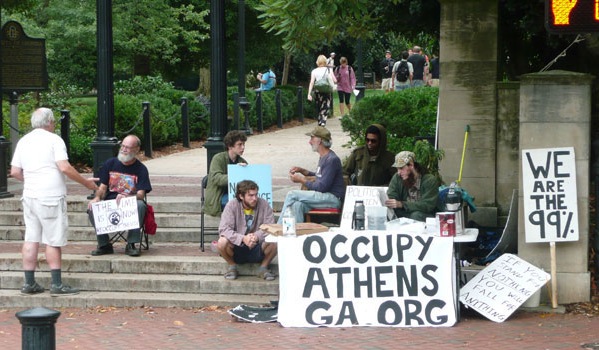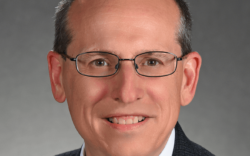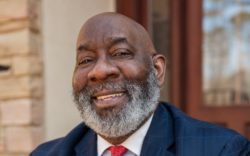All we want for National Bike Safety Month is bike lanes on Prince Avenue.
The Governor’s Office of Highway Safety, Athens-Clarke County and bike advocates marked the occasion with a press conference May 20.
No bicyclist has been killed in Athens since 2010, though there were 18 deaths statewide last year and several recent close calls in Athens. For example, Acworth college student Emily Bowman suffered brain damage when an allegedly drunk driver clipped her while she walked on the Oak Street shoulder in February. With Bowman’s father standing behind him, University of Georgia traffic researcher James Barlament identified the Oconee/Oak/Lexington corridor between Peter Street and Barnett Shoals Road as one of the 18 most dangerous in the state.
Tyler Dewey and Brent Buice, the executive directors of BikeAthens and Georgia Bikes, respectively, called for more bike infrastructure. There is safety in numbers: People don’t ride because they don’t feel safe; bike lanes make them feel safer, and more bikes on the road leads to fewer accidents because drivers become more aware, they said.
“It’s not about cyclists versus cars,” Dewey said. “It’s about making roads we can all use together.”
Commissioner Mike Hamby highlighted what ACC is already doing to improve bike safety: implementing a Complete Streets policy that gives bicyclists and pedestrians the same priority as cars, restriping roads with bike lanes (though not Prince Avenue), building median refuges, adding countdown timers to intersections and the Safe Routes to School program. But he acknowledged that more needs to be done.
“We do need to improve bicycle safety here in town, and we’ve got a mayor and commission that’s committed to doing that,” Hamby said.
OK, so let’s get started. Here are some other roads Barlament said are especially dangerous for cyclists and pedestrians:
• College Station Road from the intramural fields to Barnett Shoals Road.
• The entire University of Georgia campus, but especially the Baxter-Lumpkin Street intersection near the Tate Center.
• Prince Avenue between Oglethorpe Avenue and Pulaski Street.
Prince Avenue: At a May 20 town hall meeting on the Prince Avenue corridor study that drew about 75 people to the UGA Health Sciences Campus, residents continued to ask for transportation to be considered alongside proposed zoning changes. (ICYMI, see John Huie’s May 15 story at Flagpole.com for background.)
Suspicion still runs deep. “I think we need to see numbers, we need to see pictures, we need to see more details,” Boulevard Neighborhood Association President Dan Lorentz said.
BikeAthens Chairman Elliott Caldwell lobbied to apply Complete Streets to Prince Avenue sooner rather than later. (Oak and Oconee streets are first up to bat.) “It’s a lot of work to happen at once, but they can both be done at the same time,” he said. “It doesn’t have to be one or the other.”
Cobbham resident Amy Andrews fretted that the zoning-first approach won’t protect historic resources, in spite of ACC’s toothless demolition delay ordinance. “There’s nothing to stop anyone from demolishing any of those structures,” she said.
And several people expressed concern about why St. Joseph’s Catholic Church, which is moving from the corner of Prince Avenue and Pulaski Street to Epps Bridge Road, isn’t included in the proposed Commercial Neighborhood-Established zoning category. CN-E would allow small grocery stores, restaurants and bars, which the current Commercial-Office zoning doesn’t.
Officials left the C-O zoning in place because they want a developer to bring them an idea for approval, ACC Senior Planner Bruce Lonnee said. “It was considered to be prudent to kind of let that be something that comes to us,” he said.
The next step is for the corridor study recommendations to go to back to the Planning Commission, then to the Mayor and Commission; final dates haven’t been set.
Boulevard Woods: On a brighter note for Prince Avenue neighborhoods, a resident-driven pocket park on Barber Street across from Boulevard got a big boost last week. The Riverview Foundation, a Chattanooga, TN-based nonprofit that funds land trust acquisitions and educational and cultural activities, has donated $75,000 to fund construction of Boulevard Woods.
The two-acre passive park on donated land won Mayor and Commission approval last July, but plans will have to be approved again before moving forward. More money is needed, too, but Lorentz called it “a big step forward.”
Occupy Ordinance: About 20 citizens—including Occupy protestors holding signs—filled a City Hall meeting room last week as five ACC commissioners who serve on the Legislative Review Committee discussed an ordinance to limit nighttime access to the grounds around county-owned properties downtown.
“Obviously, this [ordinance] was inspired by the presence of Occupy members” who camped beside City Hall last spring, Commissioner Kelly Girtz told Flagpole. “That calm, peaceful act,” he said, “led to questions,” like what if future protests lasted “for months” or were less peaceful?
Last year’s tent-in at City Hall lasted only a few days, because the protesters—who were demanding more public input on the proposed Selig development—were roused out by police in the early morning hours. Police said they were blocking access to City Hall (although it wasn’t obvious they were doing so) and marking up sidewalks with chalk. The county may have had scant legal authority to make them leave, prompting Mayor Nancy Denson to assign the ordinance to the LRC.
The proposed ordinance drafted by ACC Attorney Bill Berryman would set specific hours for public access for the “campuses” around City Hall, the county courthouse and the Dougherty Street government building, but it would not apply to streets or sidewalks outside those areas. Berryman suggested barring access from 11 p.m.-6 a.m., but Commissioner Allison Wright was skeptical of closing “all the greenspace in downtown” at times of night when many businesses are still open.
“If you just wanted to sit under a tree and catch your breath,” that would become illegal at City Hall, she said. Girtz countered that street benches would still be available. The ordinance would apply only to the grounds—including the breezeway beside the courthouse—and not to parking lots, which are regulated separately.
Both Wright and commissioner Doug Lowry said they needed more time to consider such an ordinance; it was tabled until June 18. [John Huie]
Historic Preservation: At the same time, another committee, Government Operations, was discussing changing the process for designating a neighborhood historic in the wake of the extremely divisive Buena Vista Historic District fight. Widespread misinformation—like homeowners falsely believing that ACC could force them to paint their houses—and disputed facts nearly scuttled the district.
The solution: In addition to Historic Preservation Commission and county commission meetings, hold a town hall meeting so residents can informally ask questions and voice concerns earlier in the process.
Commissioners were concerned that historic district opponents didn’t have accurate information, and that they were hearing more from staunch opponents than less-enthusiastic supporters. “That’s just the nature of folks,” Planning Director Brad Griffin said. “If you get something in the mail that doesn’t make you mad, you set it down. [You] might send it back, but it’s not a high priority.”
The committee also recommended that ACC pick up the tab for printing and mailing notices and surveys to residents, and taking out mandatory legal ads in the paper. Those cost an average of about $750; neighborhood residents would still be responsible for hiring a consultant to write a designation report, which runs around $2,000. Buena Vista residents held bake sales and yard sales to raise money, Commissioner Kathy Hoard said. “Some of our low income neighborhoods could never afford” the expense, she said.
Planners will run the changes by the HPC before they go to the full commission for a vote.
Partner Benefits: As expected, Chancellor Hank Huckaby gave UGA President Michael Adams the go-ahead last week to offer “soft benefits” like dental, life and accidental death insurance (which are not subsidized by taxpayers) to the domestic partners of unmarried UGA employees in committed relationships.
Health insurance is a bit trickier, since it’s partly taxpayer-funded and the state constitution prohibits gay marriage and civil unions. Adams said that issue “unfortunately, requires further study.”
Huckaby, in a letter to Adams, suggested that, if UGA uses “truly private” dollars to pay for health insurance for domestic partners, the Board of Regents couldn’t say no. Janet Frick, the pyschology professor who’s been a driving force behind partner benefits, said she’s hopeful the UGA Foundation can raise money to make it happen.
Like what you just read? Support Flagpole by making a donation today. Every dollar you give helps fund our ongoing mission to provide Athens with quality, independent journalism.










